|
|
|
Sort Order |
|
|
|
Items / Page
|
|
|
|
|
|
|
| Srl | Item |
| 1 |
ID:
123064
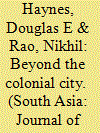

|
|
|
|
|
| Publication |
2013.
|
| Summary/Abstract |
It was long customary to begin essays on the historiography of cities in South Asia by mentioning the low level of scholarly interest once given to the study of urban pasts; 2 but a major corpus of work on this subject certainly now exists. In our view, the most important shortcomings of the existing body of scholarship now lie less in their neglect of historical urbanism than in the relative inattention given to a particular phase of urban history: the middle decades of the twentieth century. The historiography of South Asian cities has concentrated highly on what might be called 'the long nineteenth century', 3 a phase lasting from the establishment of British rule (which varied according to the region being discussed) to some point during the early twentieth century. Many of the richest works in the field confine themselves completely to nineteenth-century developments 4 or begin sometime during the late nineteenth century, edge into the initial decades of the twentieth century, and then end at some point in the 1920s or 1930s.
|
|
|
|
|
|
|
|
|
|
|
|
|
|
|
|
| 2 |
ID:
177198
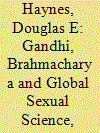

|
|
|
|
|
| Summary/Abstract |
This essay explores the evolution of Gandhi’s philosophy of brahmacharya (celibacy) after World War I. I argue here that Gandhi broadened his understanding of brahmacharya after he assumed leadership of the nationalist movement, rendering it into a concept that was applicable to the wider population of India rather than just to himself and a set of especially disciplined activists. A major reason for this development was Gandhi’s concern with deflating the claims of sexual science and birth control at a time when global sexology was gaining a foothold in Indian middle-class society. In this context, Gandhi specifically came to contest the notion that human ‘nature’ made brahmacharya inapplicable to ordinary people, suggested that husbands and wives could follow brahmacharya even while married, and insisted that the general practice of brahmacharya was essential to the collective health of the Indian nation. In the process, he imparted a significant eugenic component into his philosophy.
|
|
|
|
|
|
|
|
|
|
|
|
|
|
|
|
| 3 |
ID:
123065
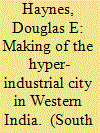

|
|
|
|
|
| Publication |
2013.
|
| Summary/Abstract |
This essay explores the rapid expansion of small handloom centres in Western India between 1930 and 1970. It attributes the transformation of these places into larger cities to the role of local weaver-capitalists, who developed new markets for local textiles and introduced significant technological innovations into the industry, and who forged strategies for combatting the growth of labour resistance. The essay also highlights the role of the late colonial and early post-Independence states, which promoted the growth of weavers' co-operatives and which imposed extensive regulations on larger enterprises. The paper argues that the powerloom centres of Western India sustained a 'hyper-industrial' quality, with limited economic or cultural diversification, restricted urban amenities and public services, and the extensive concentration of poor urban migrants in slums.
|
|
|
|
|
|
|
|
|
|
|
|
|
|
|
|
| 4 |
ID:
116078
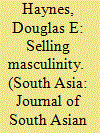

|
|
|
|
|
| Publication |
2012.
|
| Summary/Abstract |
This essay discusses advertising for sex tonics in Western Indian newspapers between 1900 and 1945. It specifically focuses on the emergence of a new paradigm of tonic advertisement-the marital happiness advertisment-after 1935. Arguing that tonic advertisers always sought to develop appeals grounded in prevously circulating conceptions of sexuality and the body, it first examines pre-1935 forms of advertisement submitted by local businesses and global corporations. It then turns to discussion of the marital happiness ads, which stress the modern husband's need to satisfy his wife sexually, demonstrating that this trope was strongly influenced by the development of global sexology. These ads, however, resorted to a hybrid reasoning, which also included the kinds of logic found in earlier advertisements, especially those about 'semen anxiety'.
|
|
|
|
|
|
|
|
|
|
|
|
|
|
|
|
| 5 |
ID:
155121
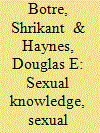

|
|
|
|
|
| Summary/Abstract |
This article examines letters written by young men to the Marathi-language journal Samaj Swasthya and its editor, R. D. Karve, a major advocate of birth control and sex education in western India. The letters, and Karve's responses to them, constituted perhaps the earliest sex-advice column in Indian print media. We argue here that the correspondence provides a unique vehicle for understanding the forms of sexual knowledge held by middle-class males in mid-twentieth-century India as well as for appreciating their most significant sexual anxieties. The article analyses the concerns expressed in the letters about masturbation and seminal emissions, the nature of the female body and processes of conception, birth control and same-sex sexual practices. It particularly illuminates the ways in which the concept of modern conjugality pervaded the sexual understandings of the young men who wrote to Karve. It thus offers valuable insights into specifically sexual aspects of conjugality and masculinity—aspects that have previously been unexplored.
|
|
|
|
|
|
|
|
|
|
|
|
|
|
|
|
|
|
|
|
|